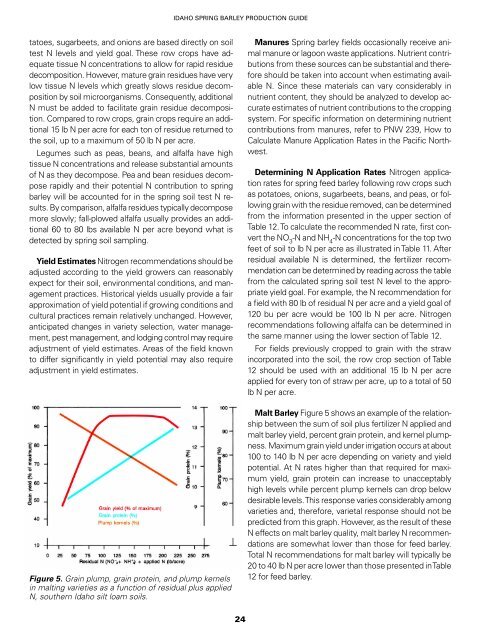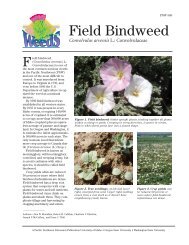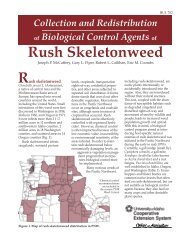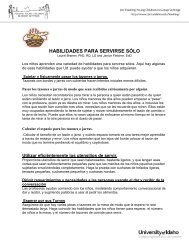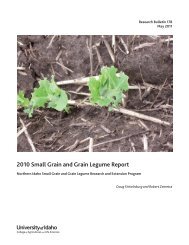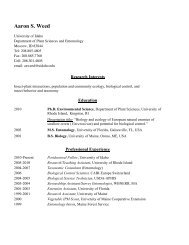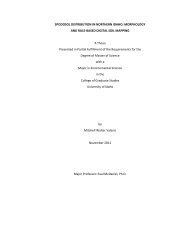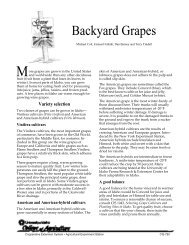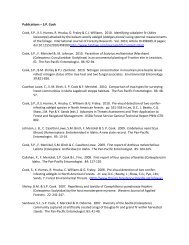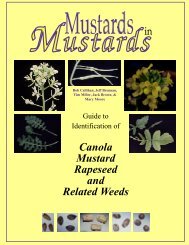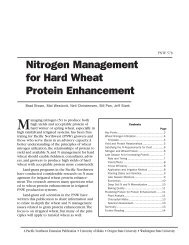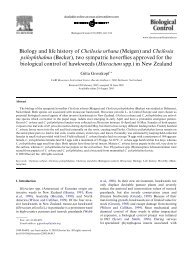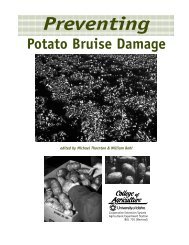Spring Barley Production Guide - College of Agricultural and Life ...
Spring Barley Production Guide - College of Agricultural and Life ...
Spring Barley Production Guide - College of Agricultural and Life ...
You also want an ePaper? Increase the reach of your titles
YUMPU automatically turns print PDFs into web optimized ePapers that Google loves.
tatoes, sugarbeets, <strong>and</strong> onions are based directly on soil<br />
test N levels <strong>and</strong> yield goal. These row crops have adequate<br />
tissue N concentrations to allow for rapid residue<br />
decomposition. However, mature grain residues have very<br />
low tissue N levels which greatly slows residue decomposition<br />
by soil microorganisms. Consequently, additional<br />
N must be added to facilitate grain residue decomposition.<br />
Compared to row crops, grain crops require an additional<br />
15 lb N per acre for each ton <strong>of</strong> residue returned to<br />
the soil, up to a maximum <strong>of</strong> 50 lb N per acre.<br />
Legumes such as peas, beans, <strong>and</strong> alfalfa have high<br />
tissue N concentrations <strong>and</strong> release substantial amounts<br />
<strong>of</strong> N as they decompose. Pea <strong>and</strong> bean residues decompose<br />
rapidly <strong>and</strong> their potential N contribution to spring<br />
barley will be accounted for in the spring soil test N results.<br />
By comparison, alfalfa residues typically decompose<br />
more slowly; fall-plowed alfalfa usually provides an additional<br />
60 to 80 lbs available N per acre beyond what is<br />
detected by spring soil sampling.<br />
Yield Estimates Nitrogen recommendations should be<br />
adjusted according to the yield growers can reasonably<br />
expect for their soil, environmental conditions, <strong>and</strong> management<br />
practices. Historical yields usually provide a fair<br />
approximation <strong>of</strong> yield potential if growing conditions <strong>and</strong><br />
cultural practices remain relatively unchanged. However,<br />
anticipated changes in variety selection, water management,<br />
pest management, <strong>and</strong> lodging control may require<br />
adjustment <strong>of</strong> yield estimates. Areas <strong>of</strong> the field known<br />
to differ significantly in yield potential may also require<br />
adjustment in yield estimates.<br />
Figure 5. Grain plump, grain protein, <strong>and</strong> plump kernels<br />
in malting varieties as a function <strong>of</strong> residual plus applied<br />
N, southern Idaho silt loam soils.<br />
IDAHO SPRING BARLEY PRODUCTION GUIDE<br />
24<br />
Manures <strong>Spring</strong> barley fields occasionally receive animal<br />
manure or lagoon waste applications. Nutrient contributions<br />
from these sources can be substantial <strong>and</strong> therefore<br />
should be taken into account when estimating available<br />
N. Since these materials can vary considerably in<br />
nutrient content, they should be analyzed to develop accurate<br />
estimates <strong>of</strong> nutrient contributions to the cropping<br />
system. For specific information on determining nutrient<br />
contributions from manures, refer to PNW 239, How to<br />
Calculate Manure Application Rates in the Pacific Northwest.<br />
Determining N Application Rates Nitrogen application<br />
rates for spring feed barley following row crops such<br />
as potatoes, onions, sugarbeets, beans, <strong>and</strong> peas, or following<br />
grain with the residue removed, can be determined<br />
from the information presented in the upper section <strong>of</strong><br />
Table 12. To calculate the recommended N rate, first convert<br />
the NO3-N <strong>and</strong> NH4-N concentrations for the top two<br />
feet <strong>of</strong> soil to lb N per acre as illustrated in Table 11. After<br />
residual available N is determined, the fertilizer recommendation<br />
can be determined by reading across the table<br />
from the calculated spring soil test N level to the appropriate<br />
yield goal. For example, the N recommendation for<br />
a field with 80 lb <strong>of</strong> residual N per acre <strong>and</strong> a yield goal <strong>of</strong><br />
120 bu per acre would be 100 lb N per acre. Nitrogen<br />
recommendations following alfalfa can be determined in<br />
the same manner using the lower section <strong>of</strong> Table 12.<br />
For fields previously cropped to grain with the straw<br />
incorporated into the soil, the row crop section <strong>of</strong> Table<br />
12 should be used with an additional 15 lb N per acre<br />
applied for every ton <strong>of</strong> straw per acre, up to a total <strong>of</strong> 50<br />
lb N per acre.<br />
Malt <strong>Barley</strong> Figure 5 shows an example <strong>of</strong> the relationship<br />
between the sum <strong>of</strong> soil plus fertilizer N applied <strong>and</strong><br />
malt barley yield, percent grain protein, <strong>and</strong> kernel plumpness.<br />
Maximum grain yield under irrigation occurs at about<br />
100 to 140 lb N per acre depending on variety <strong>and</strong> yield<br />
potential. At N rates higher than that required for maximum<br />
yield, grain protein can increase to unacceptably<br />
high levels while percent plump kernels can drop below<br />
desirable levels. This response varies considerably among<br />
varieties <strong>and</strong>, therefore, varietal response should not be<br />
predicted from this graph. However, as the result <strong>of</strong> these<br />
N effects on malt barley quality, malt barley N recommendations<br />
are somewhat lower than those for feed barley.<br />
Total N recommendations for malt barley will typically be<br />
20 to 40 lb N per acre lower than those presented in Table<br />
12 for feed barley.


